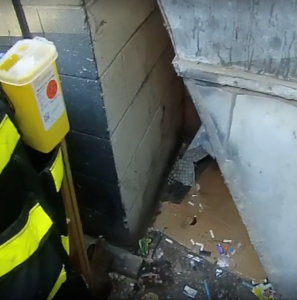Our study Strategies for Addressing Needle Debris (SANDS) looks at how municipalities can reduce discarded needles and drug paraphernalia in public spaces. Needle debris has been given as a reason to close supervised consumption sites and other community addiction services. Instead of closing services, we want to understand how to decrease needle debris to make the environment safe for everyone.
One thing we have learned – needle debris is a symptom of a lack of options. Drug paraphernalia ends up discarded in public places because people using drugs have no other options. They may lack safe disposal containers, or fear arrest if they are caught with needles. By addressing these concerns, we can decrease the number of needles that are discarded in public.
We completed a scoping review about needle debris interventions and found that needle boxes or cutters alone are not enough to prevent needle debris. Communities also need to address the legal and social issues that contribute to needle debris. For example, people may discard needles around a transit station, because they fear being arrested on the train. To respond, we can put needle disposal bins near transit stations and review whether our bylaws are pushing people away from services (like warm trains) and into more dangerous, isolated spaces.

We did a study on how media sources in Alberta talk about needle debris. Many people said that supervised consumption and overdose prevention sites increased needle debris, but other research shows that they do the opposite. Area residents and business owners are most likely to have negative views of needle debris, while people who use and work in harm reduction services are more positive. This study shows that more education is needed to help the public understand the role of supervised consumption sites in decreasing needle debris. We also need to address specific concerns raised by different stakeholder groups to decrease barriers to harm reduction services.
To study needle debris, we were the first known team in Canada to use spatial video geonarratives as a research methodology. We cross referenced location, audio, and visual information to better understand where people use drugs and why they choose these locations. This understanding will help us create specific interventions to support people in our communities who are struggling.
We also have research coming out on the perspectives of community partners in managing needle debris, the role of outreach services, different tensions around managing needle debris, and our geonarratives. Stay tuned!
